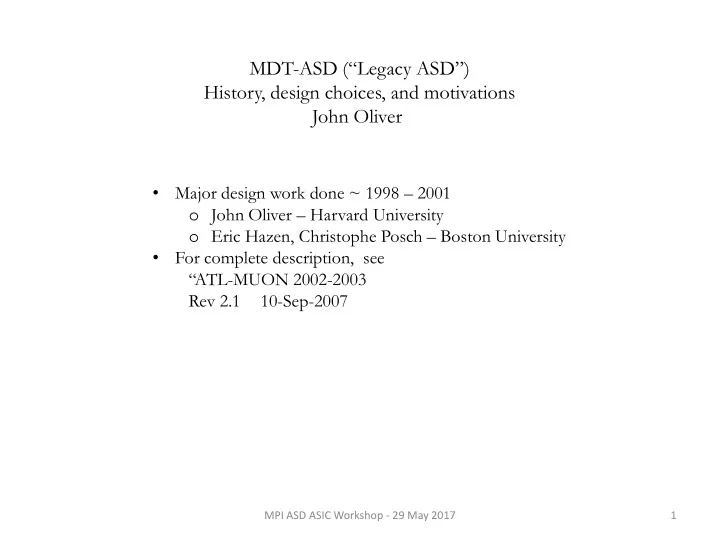

MDT-ASD (“Legacy ASD”) History, design choices, and motivations John Oliver Major design work done ~ 1998 – 2001 • o John Oliver – Harvard University o Eric Hazen, Christophe Posch – Boston University For complete description, see • “ATL-MUON 2002-2003 Rev 2.1 10-Sep-2007 MPI ASD ASIC Workshop - 29 May 2017 1
ASIC Processes for Muons – A Brief History Until 1993, we worked on Muon Spectrometer for SDC (Solenoidal • Detector Collaboration) at the Supercollider. Worked on bipolar processes with U. Penn – Transision Radiation • Detector (or was it Straw Tube Tracker?) First discussions with ATLAS started in ~ 1995 after demise of SSC • At the time, HEP community was experimenting with bipolar, • biCMOS [1] , and CMOS for detector front ends CMOS processes were available in US through MOSIS and prototypes • (MPWs) were cheap….very cheap! One could build prototype preamps for ~$5k • Scale (gate length) was getting smaller by the year 3u 1u 0.5u • We started building & testing preamp/shapers using 1u then headed to • 0.5u ~ 1997 or so Settled on HP 0.5u CMOS through MOSIS • Process was epitaxial, not by our choice, but that’s what was available (see • following slide) Process yielded peaking times ~ 15ns deemed “good enough” for MDT • shaping [1] eg “DMILL” MPI ASD ASIC Workshop - 29 May 2017 2
Bulk vs Epitaxial CMOS Transistor Guard ring structures High resistivity bulk High resistivity epi Low resistivity substrate (common to entire chip) Transient electric field lines generated in transistors tend to terminate on Guard ring structures in bulk processes • Guard ring structures and substrate in epi processes Dangerous! • Epi processes were used commercially to prevent transistor “latchup” in inverter and other • structures Note that these CMOS structures were “simple” at the time, not sophisticated as today’s • processes no “trenches” or other fancy stuff! MPI ASD ASIC Workshop - 29 May 2017 3
Passive components Resistors: Silicide blocked poly ~ 12k Ω easy a) b) Capacitors: “Linear” or MIM up to 10pf or more c) Capacitors built in two vertically opposite halves to equalize bottom plate strays MPI ASD ASIC Workshop - 29 May 2017 4
Notes a) Zin (120 Ω ) small compared with Z0 of tube (380 Ω ) b) Noise dominated by termination MPI ASD ASIC Workshop - 29 May 2017 5
Circuit Architecture & Motivation MPI ASD ASIC Workshop - 29 May 2017 6
Circuit Architecture & Motivation Concern that epitaxial process (low resistivity substrate) can lead to • substrate coupling if one is not careful Any transients coupled into substrate anywhere can couple back • into high gain input stages. Guard rings will not prevent this. • Decided on fully differential architecture all the way through. • Two independent low input impedance transimpedance • preamplifiers (Idea comes from Mitch Newcomer who used this configuration for Straw Tube Tracker [I think?] in bipolar process) Motivation for this configuration was to render any input pickup • differential, and thus cancelled by subsequent stages. This feature works “sort of” but less effective than one might • think. To be fully effective, input external (R & C) loads on both preamps would have to be the same. Actually, they are very different. Differential feature makes for easy DC balance after preamps • MPI ASD ASIC Workshop - 29 May 2017 7
Circuit Architecture & Motivation (continued) < 15ns peaking time, fast fall time Transimpedance amplifier ie • not a charge integrator Multiple gain/shaping stages with pole/zero networks to yield final • bipolar shaping All control logic (real time) is hand built and fully differential. • All real time logic traces (differential) sit over bypassed well to • further isolate from substrate. Result was that no digital substrate coupling was ever observed. • MPI ASD ASIC Workshop - 29 May 2017 8
Recommend
More recommend